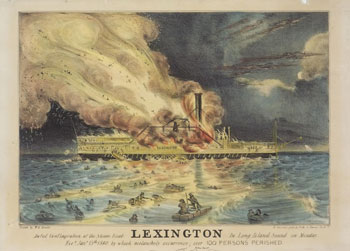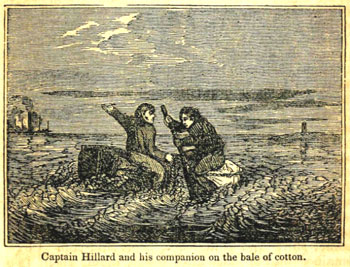The Tragic End of the Steamer Lexington
by Tom Seymour

The Lexington burning 4 miles off the north shore of Long Island, N.Y. in 1840. The ingredients for a disaster were in place when it left New York City.
An October, 1983 article in the New York Times announced that divers had found the remains of the palatial steamship, Lexington. The Times article quoted researcher Janet Warner as saying, “It was one of the most disastrous naval fires in the area’s history.”
The paddle wheeler, Lexington, was built at Bishop and Simonson Shipyards in New York in 1834. The vessel was commissioned by Cornelius Vanderbilt and built according to his specifications. There were no blueprints or other plans for the ship, but a wooden model of the hull was shaped according to Vanderbilt’s specifications. The finished vessel measured 207 feet long and weighed 496 tons.
The vessel was lavishly appointed, with teak railings, doors, paneling and staircases, a lounge and dining salon, state-of-the-art deck lighting and luxurious curtains and furniture. In other words, Lexington was a forerunner of the ill-fated Titanic.
Once placed in service, the Lexington ran day trips between New York City and Providence, Rhode Island and later, began running to Stonington, Connecticut. The Lexington was sold to the New Jersey Steamship Navigation and Transportation Company in 1838 and up until 1840, Lexington had the distinction of being the fastest vessel to run between New York City and Boston.
Poor Planning
One reason for the Lexington’s speed was that the New Jersey Steamship Navigation and Transportation Company, immediately upon purchasing the vessel, converted her wood-fired boilers to coal. The coal was coaxed into burning even hotter by fans. This was to prove a recipe for disaster.
According to an article in Brooklyn Genealogy by Steve Morse, January 13, 1840 saw the mercury hovering around 0 degrees. Even so, preparations for the afternoon departure commenced, with 150 cotton bales stowed beneath the deck. Some bales were dangerously close to the smokestack casing. This was despite a recent fire in that same casing. The fire was extinguished, limited damage was repaired and no one gave a thought that just perhaps, a similar situation could occur again.
The cotton was piled
within perhaps a foot
of the steam chimney.
In addition to cotton bales, the Lexington took on 115 passengers, all of whom immediately went inside for relief from the cold. Passengers paid a greatly reduced fare if they remained on deck for the voyage, but no one felt hardy enough that day to brave the sub-zero windchills.
As the Lexington hit the open sea, the crew added even more coal to the fire in an attempt to prompt the vessel to attain a greater speed against a brisk north wind. According to an 1840 story in the New York newspaper Extra Sun, as well as firsthand testimony given to the 26th Congress, the Lexington was 50 miles out of the port on New York and 4 miles off of Long Island’s North Shore, when someone discovered that woodwork and casings around the smokestack were ablaze.
Pilot Stephen Manchester, at the helm at the time fire was discovered, said, “My first movement was to step out of the wheel-house and look aft. I saw the upper deck on fire all around the smoke-pipe and blazing up two or three feet, perhaps, above the promenade deck. The flame seemed to be a thin sheet and, apparently, but just commenced; the blaze seemed to follow up the smoke-pipe and was all around it. I thought from the first view that it was a doubtful case whether it could be extinguished.”
After that, Captain George Childs, a fill-in captain for the trip, came up from below deck and entered the wheelhouse. Soon after, smoke became so thick that Childs was compelled to abandon that post.

Large bales of cotton became floatation and insulation for some. A passenger on one shared the bale, but soon perished from the cold.
Then the alarm sounded and a hand-pumped fire engine was enlisted. But of the several dozen buckets said to be on board, only two or three were located. A bucket of silver belonging to a passenger was emptied and used for water, but it soon became apparent that the fire was too fierce, too hot, for the meager equipment available to affect any good outcome. By that time the rope controlling the rudder burned through. With the helpless vessel headed toward shore at full speed, it was hoped that she could be safely beached. But 2 miles short of that goal the engines played out, leaving the burning vessel dead on the water.
Pilot Manchester later testified, “In my opinion, the fire originated from the heat of the smoke-pipe, which was communicated to the woodwork. I have frequently seen the smoke-pipe red hot, and so it was on the last night. I do not know whether the red heat extended to the flange or not. The cotton was piled within perhaps a foot of the steam chimney.”
People on shore for miles around later testified to seeing the flames. Many would have rushed out to lend assistance, but low tide, ice and howling seas prohibited any rescue vessels from leaving their anchorages.
As flames leapt as high as the smokestack and the cotton bales burned at a ferocious rate, Captain Childs ordered the lifeboats launched. As the crew was preparing a boat, frenzied passengers rushed to board it, filling well over its approved capacity. The boat and passengers were swept into the wake of the paddlewheel and boat and passengers were lost.
Second Mate
Dave Crowley managed
to burrow into the center
of a cotton bale.
Others were able to throw some yet-unburned cotton bales overboard and used them as life rafts. But the freezing cold was too much for the soaked and shivering passengers and most of those on the water perished. At 3:00 a.m. the next day, the Lexington slowly descended into Long Island Sound.
Of the 115 passengers, only four survived, three crew members and one passenger. Three of these suffered frostbite. But Second Mate Dave Crowley managed to burrow into the center of a cotton bale and thus remained somewhat warm. Crowley shared his cotton bale with a passenger who soon perished from the cold. Crowley was afloat in his cotton bale for 48 hours before washing ashore. Crowley somehow saved the bale and kept it in his home as a reminder of the event and only disposed of it when the Civil War broke out and cotton was needed for the Union effort.
For days afterward, bodies washed ashore on Long Island’s North Shore.
Two years later, the Lexington was lifted to the surface, but chains holding the vessel broke, sending it back down to the bottom. But not before a 30-pound mass of melted silver was recovered. However, another passenger was reported to have taken gold coins aboard and those, if present, went back to the bottom with the remains of the burnt vessel.
In a day when most newspapers did not include drawings or pictures along with text, the public was amazed when New York City’s largest newspaper, the New York Sun, published a color picture of the Lexington at the height of the conflagration. This was a great success for Nathaniel Currier, of Currier & Ives fame, and Currier ran his presses for months afterward in order to keep up with public demand.
Later, in 1852, Congress passed The Steamboat Act of 1830, which mandated testing of boilers and safety valves. It also required testing for all pilots.
Lexington Located
Henry Wadsworth Longfellow
had purchased a ticket to
board the Lexington on
that fateful day.
On October 12, 1983, The New York Times published an article by James Barron, announcing the location of the Lexington. According to the article, divers had found the wreck in three sections, sitting upright in 80 feet of water. The divers research revealed records of the ship carrying $20,000 in paper currency and somewhere between $18,000 and $40,000 in silver coins. No mention was made of the gold coins purported to be on board.
Clive Cussler, chairman of the National Underwater and Marine Agency, Inc., a nonprofit organization dedicated to locating historical shipwrecks, estimated that silver still sitting on the wreck was worth over $100,000 by today’s standards.
Researchers located the wreck’s location by analyzing data on current and drift patterns. Then they simulated the Lexington’s last hours by allowing their research vessel to drift under conditions similar to what the Lexington experienced. After weeks of scanning the area where the Lexington was thought to have gone down, scanning equipment detected an image on the bottom. The image clearly showed the paddle wheel and also indicated that the hull was probably intact.
In an ironic twist of fate, Henry Wadsworth Longfellow had purchased a ticket and was scheduled to board the Lexington on that fateful day. But Longfellow was over-long in arguing with his publisher about his poem, “The Wreck of The Hesperus,” a poem that detailed the wreck of a ship in a great storm off the New England coast. And so Longfellow arrived too late to board.
Nathaniel Currier went on to everlasting fame as his newly formed company, Currier & Ives went on to chronicle American history. Many Currier & Ives prints depicted shipwrecks.
